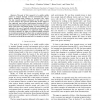720 search results - page 55 / 144 » Mobile robot navigation using sensor fusion |
ML
1998
ACM
13 years 8 months ago
1998
ACM
To operate successfully in indoor environments, mobile robots must be able to localize themselves. Most current localization algorithms lack flexibility, autonomy, and often optim...
AROBOTS
2002
13 years 8 months ago
2002
We describe techniques to optimally select landmarks for performing mobile robot localization by matching terrain maps. The method is based upon a maximum-likelihood robot localiza...
TROB
2008
13 years 8 months ago
2008
Abstract--We evaluate a technique that uses an embedded network deployed pervasively throughout an environment to aid robots in navigation. The embedded nodes do not know their abs...
ICRA
2010
IEEE
13 years 7 months ago
2010
IEEE
— The goal of this research is to enable mobile robots to navigate through crowded environments such as indoor shopping malls, airports, or downtown side walks. The key research ...
CIRA
2007
IEEE
14 years 3 months ago
2007
IEEE
Abstract— In human-robot communication it is often important to relate robot sensor readings to concepts used by humans. We believe that access to semantic maps will make it poss...

